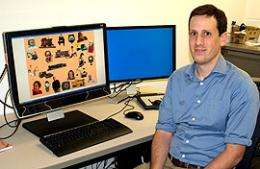Eye Movements May Help Detect Autism

(PhysOrg.com) -- Most parents will attest that infants convey their needs and interests in a variety of ways, many times without ever making a sound. For researchers in the School of Behavioral and Brain Sciences, it is what babies communicate with their eyes that could be key to understanding the development of certain disabilities, including autism.
Dr. Noah Sasson, an assistant professor in the school, and his colleagues at the UT Dallas Center for Children and Families, are currently tracking and measuring the eye movements of infants. Eye tracking technology is nothing new to Sasson — he has used it in previous research to investigate how children and adults perceive social and non-social information.
“By tracking eye movements, we can infer information about an infant based on what he or she views and for how long,” said Sasson. “Although this information alone is not diagnostic, certain patterns of eye movements may signify an abnormality that could reflect potential developmental difficulties.”
Researchers collect the data by having infants sit on their parent’s lap and face a computer monitor. An array of images is projected on the monitor, and a Tobii eye tracker — a standalone unit designed for just such studies — instantly measures the eye movements.
Included in the array are social images, such as people and faces, and objects that are often of high interest to children with autism, such as trains, cars and computers, as well as objects that may be less appealing to children with autism, such as clothes and furniture.

Previous research has shown that children with autism are more likely to view high interest objects more frequently and for longer periods of time than social or low interest objects. More research is needed before the results can help determine whether a child might be at greater risk for developing autism.
“We know from experience that early intervention can lessen the effects of autism traits in both childhood and adulthood,” said Sasson. “The goal of our research is to detect a problem as soon as possible so that parents can then proceed with early intervention programs.”
Sasson is conducting the study in conjunction with the Infant Development Program. It is designed for infants up to 30 months of age and includes both clinical screenings and research. All activities take place at the Callier Center for Communication Disorders.
Provided by UT Dallas
















